Monographs: Pharmaceutical substances: Remdesivir (Remdesivirum)
Molecular formula. C27H35N6O8P
Relative molecular mass. 602.6
Graphic formula
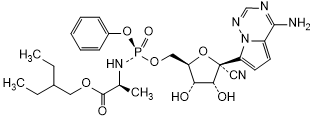
Chemical name. 2-Ethylbutyl (2S)-2-{[(S)-{[(2R,3S,4R,5R)-5-(4-aminopyrrolo[2,1-f][1,2,4]triazin-7-yl)-5-cyano-3,4-dihydroxytetrahydrofuran-2-yl]methoxy}(phenoxy)phosphoryl]amino}propanoate or 2-Ethylbutyl N-{(S)-[2-C-(4-aminopyrrolo[2,1-f][1,2,4]triazin-7-yl)-2,5-anhydro-d-altrononitril-6-O-yl]phenoxyphosphoryl}-l-alaninate (IUPAC), l-Alanine, N-[(S)-hydroxyphenoxyphosphinyl]-, 2-ethylbutyl ester, 6-ester with 2-C-(4-aminopyrrolo[2,1-f][1,2,4]triazin-7-yl)-2,5-anhydro-d-altrononitrile (CAS); CAS Reg. No. 1809249-37-3.
Description. A white to off-white to slightly yellow powder.
Solubility. It is soluble in ethanol (~750 g/L) TS, freely soluble in methanol R and sparingly soluble in dimethylsulfoxide R. It is practically insoluble in water R.
Category. Antiviral.
Storage. Remdesivir should be kept in tightly closed containers, protected from moisture.
Additional information. Remdesivir exhibits polymorphism.
Requirements
Definition. Remdesivir contains not less than 96.0% and not more than 102.0% of C27 H35N6O8P, calculated with reference to the anhydrous substance.
Identity tests
-
Either test A or test B alone or any two of tests C, D and E may be applied.
-
Carry out the test as described under 1.7 Spectrophotometry in the infrared region. The infrared absorption spectrum is concordant with the spectrum obtained from remdesivir RS or with the reference spectrum of remdesivir.
If the spectra thus obtained are not concordant, repeat the test using the residues obtained by separately dissolving the test substance and remdesivir RS in a small amount of methanol R and evaporating to dryness. The infrared absorption spectrum is concordant with the spectrum obtained from remdesivir RS.
-
Carry out the test as described under 1.14.1 Chromatography, High-performance liquid chromatography, using the conditions given under "Assay" but using, as the detector, a diode array detector to record the UV spectrum of the principal peak in each chromatogram in the range of 220 nm to 400 nm. The retention time and the UV spectrum of the principal peak in the chromatogram obtained with solution (1) correspond to the retention time and the UV spectrum of the peak due to remdesivir in the chromatogram obtained with solution (2).
-
Carry out the test as described under 1.14.1 Chromatography, High-performance liquid chromatography, using the conditions given under "Assay". The retention time of the principal peak in the chromatogram obtained with solution (1) corresponds to the retention time of the peak due to remdesivir in the chromatogram obtained with solution (2).
-
Carry out the test as described under 1.14.1 Chromatography, Thin-layer chromatography using silica gel R6 as the coating substance and a freshly prepared mixture of ethyl acetate R, methanol R and glacial acetic acid R (90:9:1 V/V/V) as the mobile phase. Apply separately to the plate 2 µL of each of the following two solutions in methanol R, containing (A) 1 mg of the test substance per mL and (B) 1 mg of remdesivir RS per mL. After removing the plate from the chromatographic chamber allow it to dry in air or in a current of air. Examine the chromatogram under ultraviolet light (254 nm). The principal spot in the chromatogram obtained with solution (A) corresponds in position, appearance and intensity with the spot due to remdesivir in the chromatogram obtained with solution (B).
-
The absorption spectrum (1.6 Spectrophotometry in the visible and ultraviolet regions) of a 0.03 mg per mL solution of the test substance in methanol R, when observed between 220 nm and 400 nm, exhibits two maxima at about 245 nm and 275 nm.
Specific optical rotation (1.4). Use a 10.0 mg per mL solution of the test substance in methanol R and sonicate until the substance is dissolved. The specific optical rotation, calculated with reference to the anhydrous substance, is between -25.0 to -18.0.
Water. Determine as described under 2.8 Determination of water by the Karl Fischer method, Method A. Use 0.500 g of the test substance. The water content is not more than 10 mg/g.
Heavy metals. Use 0.30 g for the preparation of the test solution as described under 2.2.3 Limit test for heavy metals, Procedure 5; determine the heavy metals content according to Method C; not more than 10 μg/g.
Related substances . Carry out the test as described under 1.14.1 Chromatography, High-performance liquid chromatography, using a stainless steel column (4.6 mm x 15 cm) packed with particles of silica gel, the surface of which has been modified with chemically-bonded octadecylsilyl groups (3 µm).
Use the following conditions for gradient elution:
- Mobile phase A: phosphoric acid solution;
- Mobile phase B: acetonitrile for chromatography R.
Prepare the phosphoric acid solution by diluting 1.2 mL of phosphoric acid (~1440 g/L) TS to 1000 mL with water R.
|
Time (minutes) |
Mobile phase A (% v/v) |
Mobile phase B (% v/v) |
Comments |
|
0–3 |
97 |
3 |
Isocratic |
|
3–45 |
97 to 30 |
3 to 70 |
Linear gradient |
|
45–53 |
30 |
70 |
Isocratic |
|
53–54 |
30 to 97 |
70 to 3 |
Return to initial composition |
|
54–65 |
97 |
3 |
Re-equilibration |
Operate with a flow rate of 1.0 mL per minute. As a detector, use an ultraviolet spectrophotometer set at a wavelength of 237 nm. Maintain the column temperature at 30 °C.
Prepare as a diluent a mixture of 50 volumes of methanol R and 50 volumes of water R.
Prepare the following solutions: for solution (1), dissolve 25.0 mg of the test substance in 5 mL of methanol R and dilute to 50.0 mL with the diluent. For solution (2), dilute 1.0 mL of test solution (1) to 100.0 mL with the diluent. For solution (3), dilute 1.0 mL of solution (2) to 10.0 mL with the diluent. For solution (4), dissolve and dilute remdesivir for system suitability RS (containing remdesivir and impurity A) as described in the leaflet of the reference substance.
Inject 5 µL each of solutions (1), (2), (3) and (4).
Use the chromatogram obtained with solution (4) and the chromatogram supplied with remdesivir for system suitability RS to identify the peak due to impurity A. The impurities are eluted, if present, at the following relative retentions with reference to remdesivir (retention time about 28 minutes): impurity E about 0.18; impurity G about 0.46; impurity H about 0.51; impurity I about 0.74; impurity C and impurity D about 0.84; impurity A about 0.98; impurity B about 1.03 and impurity F about 1.30.
The test is not valid unless, in the chromatogram obtained with solution (4), the resolution between the peaks due to impurity A and remdesivir is at least 1.5. Also, the test is not valid unless, in the chromatogram obtained with solution (3), the peak due to remdesivir is obtained with a signal-to-noise ratio of at least 20.
In the chromatogram obtained with solution (1):
-
the area of any peak corresponding to either impurities A, F or G is not greater than 0.5 times the area of the peak due to remdesivir in the chromatogram obtained with solution (2) (0.5 %);
-
the area of any peak corresponding to impurity E, when multiplied with a correction factor of 0.5, is not greater than 0.5 times the area of the peak due to remdesivir in the chromatogram obtained with solution (2) (0.5 %);
-
the area of any peak corresponding to impurity I is not greater than 0.4 times the area of the peak due to remdesivir in the chromatogram obtained with solution (2) (0.4%);
-
the area of any peak corresponding to either impurities B or H is not greater than 1.5 times the area of the peak due to remdesivir in the chromatogram obtained with solution (3) (0.15 %);
-
the sum of the areas of any peaks corresponding to impurities C and D (impurities C and D co-elute) is not greater than 1.5 times the area of the peak due to remdesivir in the chromatogram obtained with solution (3) (0.15 %);
-
the area of any other impurity peak is not greater than the area of the peak due to remdesivir in the chromatogram obtained with solution (3) (0.10 %).
-
The sum of the areas of all impurity peaks, including the corrected area of any peak corresponding to impurity E, is not greater than two times the area of the peak due to remdesivir in the chromatogram obtained with solution (2) (2.0%). Disregard all peaks with an area of less than 0.5 times the area of the peak due to remdesivir in the chromatogram obtained with solution (3) (0.05%).
Assay. Carry out the test as described under 1.14.1 Chromatography, High-performance liquid chromatography, using a stainless steel column (4.6 mm x 25 cm) packed with end-capped particles of silica gel, the surface of which has been modified with chemically-bonded octadecylsilyl groups (5 µm).
Prepare a phosphoric acid solution by diluting 1.2 mL of phosphoric acid (~1440 g/L) TS to 1000 mL with water R. As the mobile phase, use a mixture of 35 volumes of the phosphoric acid solution and 65 volumes of methanol R.
Operate with a flow rate of 1.0 mL per minute.
As a detector, use an ultraviolet spectrophotometer set at a wavelength of 237 nm. Maintain the column temperature at 25 °C.
Prepare as a diluent a mixture of 50 volumes of methanol R and 50 volumes of water R.
Prepare the following solutions: for solution (1), dissolve 40.0 mg of the test substance in 10 mL of methanol R, dilute to 200.0 mL with the diluent. For solution (2), dissolve 40.0 mg of remdesivir RS in 10 mL of methanol R and dilute to 200.0 mL with the diluent.
Inject 5 µL each of solutions (1) and (2) and record the chromatogram for 20 minutes. Remdesivir elutes about 10 minutes.
Measure the areas of the peaks corresponding to remdesivir obtained in the chromatograms of solutions (1) and (2) and calculate the percentage content of C27H35N6O8P in the sample using the declared content of C27H35N6O8P in remdesivir RS.
Impurities
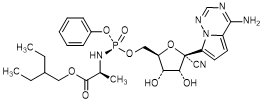
A. 2-Ethylbutyl (2S)-2-{[(R)-{[(2R,3S,4R,5R)-5-(4-aminopyrrolo[2,1-f][1,2,4]triazin-7-yl)-5-cyano-3,4-dihydroxytetrahydrofuran-2-yl]methoxy}(phenoxy)phosphoryl]amino}propanoate (remdesivir diastereomer) (synthesis related impurity).
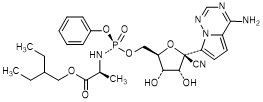
B. 2-Ethylbutyl (2S)-2-{[(S)-{[(2R,3S,4R,5S)-5-(4-aminopyrrolo[2,1-f][1,2,4]triazin-7-yl)-5-cyano-3,4-dihydroxytetrahydrofuran-2-yl]methoxy}(phenoxy)phosphoryl]amino}propanoate (remdesivir diastereomer) (synthesis related impurity).
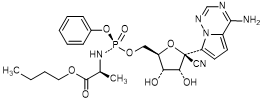
C. Butyl (2S)-2-{[(S)-{[(2R,3S,4R,5S)-5-(4-aminopyrrolo[2,1-f][1,2,4]triazin-7-yl)-5-cyano-3,4-dihydroxytetrahydrofuran-2-yl]methoxy}(phenoxy)phosphoryl]amino}propanoate (synthesis related impurity).
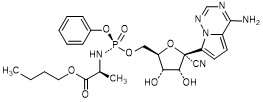
D. Butyl (2S)-2-{[(S)-{[(2R,3S,4R,5R)-5-(4-aminopyrrolo[2,1-f][1,2,4]triazin-7-yl)-5-cyano-3,4-dihydroxytetrahydrofuran-2-yl]methoxy}(phenoxy)phosphoryl]amino}propanoate (synthesis related impurity).

E. (2R,3R,4S,5R)-2-(4-aminopyrrolo[2,1-f][1,2,4]triazin-7-yl)-3,4-dihydroxy-5-(hydroxymethyl)tetrahydrofuran-2-carbonitrile (synthesis related impurity, degradation product).
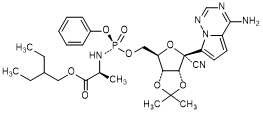
F. 2-Ethylbutyl (2S)-2-{[(S)-{[(3aR,4R,6R,6aR)-6-(4-aminopyrrolo[2,1-f][1,2,4]triazin-7-yl)-6-cyano-2,2-dimethyltetrahydrofuro[3,4-d][1,3]dioxol-4-yl]methoxy}(phenoxy)phosphoryl]amino}propanoate (synthesis related impurity).

G. [(2R,3S,4R,5R)-5-(4-aminopyrrolo[2,1-f][1,2,4]triazin-7-yl)-5-cyano-3,4-dihydroxytetrahydrofuran-2-yl]methyl phenyl hydrogenphosphate (synthesis related impurity, degradation product).
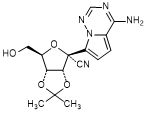
H. (3aR,4R,6R,6aR)-4-(4-aminopyrrolo[2,1-f][1,2,4]triazin-7-yl)-6-(hydroxymethyl)-2,2-dimethyltetrahydrofuro[3,4-d][1,3]dioxole-4-carbonitrile (synthesis related impurity).
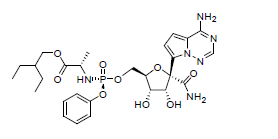
I. 2-Ethylbutyl (2S)-2-{[(S)-{[(2R,3S,4R,5R)-5-(4-aminopyrrolo[2,1-f][1,2,4]triazin-7-yl)-5-carbamoyl-3,4-dihydroxytetrahydrofuran-2-yl]methoxy}(phenoxy)phosphoryl]amino}propanoate (synthesis related impurity, degradation product).